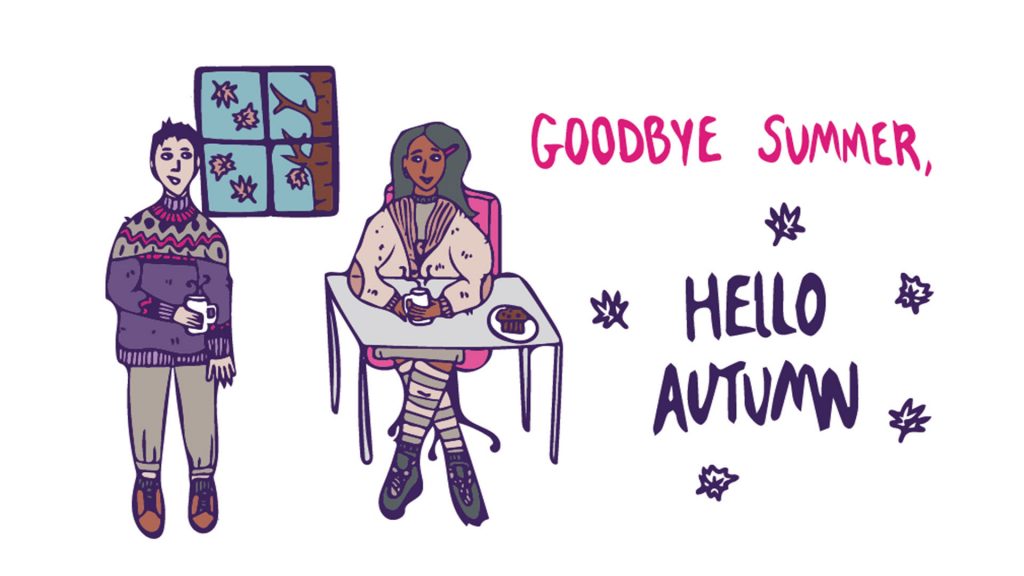Goodbye summer, hello autumn

With the transition of seasons from summer to autumn, we’re all beginning to notice the drop in temperature and the increasingly darker mornings and evenings each day.
In this article, the University’s Sustainability Manager Jo Shields explains how you can keep warm whilst looking after the environment by choosing sustainable fabrics that boast impressive properties.
As the days get shorter and the mercury begins to fall, I have finally given in and done my summer to winter clothes swap. The Birkenstocks have gone to the back of the shoe cupboard, and the boots back upfront.
If you want to be prepared for the cold season, you should consider which fabrics will keep you warm and cosy. Layers are also a great way to prepare for changes in temperature and deal with the great British weather.
Remember, there is no such thing as bad weather, just bad clothes. For example, did you know that anywhere between 30%-50% of heat is lost through your head? So if you’re cold, a top tip of mine is to wear a hat!
Fabrics to keep you warm
Wool, cashmere, hemp, flannel, mohair and cotton are all great materials to look for in clothing as the weather turns cooler. These types of fabrics will generally have a tighter weave so will trap air rather than letting it pass through. The more air your clothing hangs onto, the warmer you will be as it naturally insulates your body.
There are other fabrics available as well, but they are not natural and tend to be derived from oil so they are not as sustainable, although still very effective as base layers and for warmth. In this blog, I am going to focus on warm, sustainable fabrics you can incorporate into your winter wardrobe.
Wool – If you’re after a natural option to keep you warm this winter, wool is your answer. Merino wool is a particular favourite of mine. It is more expensive, but if you look after it will last for years. Wool has the ability to trap air in little pockets, providing excellent insulation.
Hemp – It’s warm, soft and has a low impact on the environment.
Flannel – This is wool that has been brushed to lift the fibres so it can trap the heat better and feels very soft against the skin.
Organic Cotton – Much better for farming and the land with crops produced toxin-free. It protects the eco-systems by using less water and the people working on farms are treated better too. It is also softer than normal cotton and hypoallergenic.
Bamboo – This is a personal favourite of mine and it is great for the environment as it is a fast-growing crop. Bamboo is antibacterial, meaning you’ll smell fresh all day too. It is also an extremely soft fabric and will keep you warm throughout the winter months by wicking sweat away from your body.
Linen – It is naturally insulating due to its hollow fibres and it dries faster than cotton.
Soybeans – Soybean fibre is a material derived from food production waste, making it even better for the planet. It is occasionally called the vegetable cashmere and it’s certainly a lot cheaper than this expensive, animal-derived product. Better yet, any garments made from this material are soft and very easy to look after, so they should last you for many years.
rPET (Recycled Polyester) – One of my favourite dresses is made from this and bonus – you don’t need to iron it! Anyone interested in the environment knows the damage that plastic is causing to the entire planet. To combat this, manufacturers are using polyethylene terephthalate and recycling it to create a material called rPET. This material is essentially made from plastic bottles used by consumers.
Tencel – Made from wood, this material can be used to create everything from warm jumpers to lighter trousers. Better yet, it is made using a closed-loop technology. As a result, chemicals and water are reused, reducing the impact on the planet.
In summary, there are many fibres used in clothing that can help keep you warm and have a low impact on the environment. It is always worth having a quick look at the labels to see what an item is made from.
I would also strongly advocate buying second hand. I would say half of my wardrobe is made up of charity shop finds; my latest is a 100% cashmere jacket and last winter I managed to find a 100% wool coat for £4.50 with the original labels still on.
Stay warm, stay safe and check out your local charity shop…you might just surprise yourself with what you will find.
Find out more about the Sustainability team on their website, and check out their dedicated blog, Sustainably Speaking.
Health and Wellbeing
Wellbeing means being in a positive physical, social and mental state. Wellbeing is important to us as happy, healthy people who achieve harmony in their work / life mix are more creative, productive and help to create a great place to work.